Discover Beijing’s Best Century-Old Restaurants(2025 update)
Beijing is not just about ancient landmarks—it’s a city where history is served on a plate. For travelers eager to explore authentic flavors, the city’s century-old restaurants are a must-try. These iconic spots have been perfecting their dishes for over 100 years, offering everything from crispy Peking duck to tender lamb hotpot. Join us as we dive into the flavors of Beijing’s culinary heritage, where every bite tells a story.
Recommended Restaurants
I. Mutton Hotpot Specialists: The Soul of Beijing Cuisine
-
Dong Lai Shun
Location: Wangfujing, near the Forbidden City | Avg. ¥180 per person
History & Uniqueness:
Established in 1903, Dong Lai Shun is one of Beijing’s most renowned spots for shuan yang rou (instant-boiled mutton), a local delicacy. The restaurant is famous for its unique approach to hotpot, serving lamb that is sliced paper-thin and cooked in a delicate broth right at the table.
Signature Dishes:
-
Shuan Yang Rou: Thinly sliced lamb, cooked in a light broth, and served with a rich sesame dipping sauce (¥158). The lamb’s tenderness and the simplicity of the dish make it a perfect introduction to Beijing’s hotpot culture.
-
Handmade Sesame Sauce: A rich and nutty dip that enhances the mutton’s flavor (¥20).
Compared to other hotpot restaurants, Dong Lai Shun stands out for its delicate approach to seasoning and preparation, with a focus on the purity of the meat’s natural flavors.

-
Nanmen Shuanrou
Location: Qianmen area, near the Temple of Heaven | Avg. ¥140 per person
History & Uniqueness:
Founded during the Republic of China era, Nanmen Shuanrou is another iconic destination for shuan yang rou. Known for its thicker slices of lamb and bold, aromatic broth, Nanmen offers a slightly different experience than Dong Lai Shun.
Signature Dishes:
-
Copper Pot Mutton: Thick lamb slices that retain their juicy, meaty texture (¥138). The broth is enriched with goji berries, giving it a natural sweetness.
-
Spicy Dipping Sauce: For those who like a spicy kick, this sauce adds extra depth (¥18).
While both Dong Lai Shun and Nanmen Shuanrou specialize in mutton hotpot, Nanmen offers a heartier, spicier experience, perfect for those seeking bolder flavors.
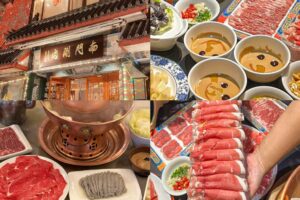
II. Peking Duck Masters: Two Schools of Excellence
-
Bianyifang
Location: Hademen, near Qianmen Street | Avg. ¥220 per person
History & Uniqueness:
Founded in 1416, Bianyifang is considered one of Beijing’s oldest and most revered Peking duck restaurants. Known for its closed-oven roasting method, Bianyifang has kept this traditional technique alive for centuries.
Signature Dishes:
-
Closed-Oven Roast Duck: Duck roasted in a sealed clay oven for enhanced tenderness and a crisp, golden skin (¥288 per duck).
-
Kung Pao Chicken: Tender wok-fried chicken with crisp peanuts, balanced sweet-spicy sauce, and aromatic Sichuan peppercorns (¥68).
While Quanjude is famous for its open-oven method, Bianyifang’s closed-oven version is preferred by many for its juiciness and subtly smoky flavor.
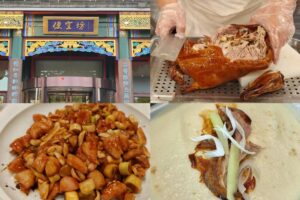
-
Siji Minfu
Location: Houhai Lake area | Avg. ¥180 per person
History & Uniqueness:
A newer addition to the Peking duck scene, Siji Minfu has quickly become a favorite among both locals and visitors. The restaurant's modern approach to traditional duck preparation offers a slightly different flavor profile.
Signature Dishes:
-
Open-Oven Roast Duck: A slightly different take on the classic, with a smoky aroma and crisp skin (¥198 per duck).
-
Tender Pea Shoots Salad: Essential pairing – Fresh young pea shoots lightly dressed with sesame oil and vinegar, offering a crisp, refreshing contrast to rich duck (¥38).
Siji Minfu’s Peking duck is less fatty than Bianyifang’s, with a more distinct smoky flavor, making it ideal for those seeking a modern twist on the classic.
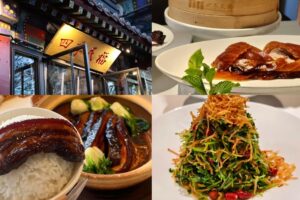
III. Halal Heritage: Uyghur & Northern Flavors
-
Bao Du Feng
Location: Near Xidan Shopping District | Avg. ¥120 per person
History & Uniqueness:
For a truly authentic Beijing street food experience, Bao Du Feng offers a taste of old Beijing with its specialty in boiled beef tripe. The restaurant prides itself on its high-quality ingredients and quick-cook technique that ensures the tripe retains its tender, chewy texture.
Signature Dishes:
-
Classic Boiled Tripe – Beef tripe cooked to perfection and served with sesame and garlic sauce (¥88).
-
Lamb Spine Pot – A hearty, aromatic stew made with lamb bones and herbs (¥138).
-
Spicy Chili Oil Condiments – A must-try for those who enjoy a fiery kick with their meal (¥18).
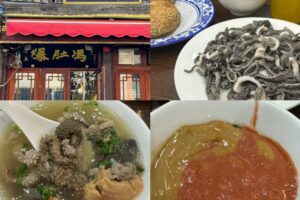
-
Kaorou Yuan
Location: Xisi area, near Beihai Park | Avg. ¥160 per person
History & Uniqueness:
One of Beijing’s premier halal restaurants, Kaorou Yuan has been serving Muslim-style lamb barbecue since the early 1900s, known for its expertly marinated lamb and charcoal grilling technique.
Signature Dishes:
-
Charcoal-Grilled Lamb Chops – Grilled to perfection with cumin and chili, these tender chops offer a perfect balance of smoky and spicy (¥168).
-
Tendon & Lean Meat Strips: Textural masterpiece – Chewy beef tendon and tender lean meat skewered and grilled until caramelized, finished with toasted cumin-chili crust (¥58).
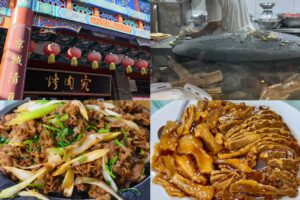
IV. Imperial & Shandong-Inspired Cuisine
-
Liuyuanju
Location: Deshengmen, near the Ancient City Wall Ruins | Avg. ¥150 per person
History & Uniqueness:
Liuyuanju,the only surviving "Ju", transitioned from a yellow wine tavern to a fine restaurant. Founded as "Liuquanju Huangjiu Guan" , named after its ancient well and willow trees. Famed for artisanal "Jade Spring Wine" and literary gatherings (patrons included Lu Xun).
Signature Dishes:
-
Walnut Chicken in Savory Bean Sauce: Qing court-inspired wok-seared chicken with crisp walnuts (¥98).
-
Claypot Braised Eggplant: Meltingly soft eggplant in garlic-soy glaze (¥58).
-
Heritage Bean Paste Buns: Beijing’s original doubao – Coarse red-bean paste simmered with rock sugar, wrapped in dough fermented with wine yeast. Slightly floral, not cloying (¥15/6pc).
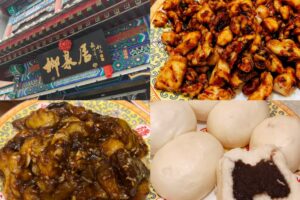
-
Cuihualou
Location: Chongwenmen, near the Ming City Wall Relics Park | Avg. ¥160 per person
History & Uniqueness:
Founded in 1867, Cuihualou is famed for its Shandong-influenced Beijing cuisine. Its dishes focus on fresh ingredients, light flavors, and simple yet delicate cooking techniques.
Signature Dishes:
-
Sweet and Sour Mandarin Fish: A crispy, tangy-sweet fish dish that is a Beijing classic (¥138).
-
Cuihua Baked Flaky Rolls: Rolls are steamed, then baked to achieve a crisp golden crust and cloud-soft, honeycomb-textured interior (¥38).
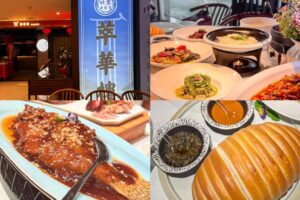
curated routes for food & sights
Route 1: Imperial Heartland Feast
Forbidden City → Wangfujing → Qianmen
Theme: Royal cuisine meets folk traditions
Stops:
-
Lunch: Dong Lai Shun (王府井)After Forbidden City tour (10-min walk)→ Try Hand-Sliced Mutton beside emperors’ old playground.
-
Sight: Qianmen Street (前门大街)Explore Ming-era shopping street (20-min walk south).
-
Dinner: Nanmen Shuanrou (南门涮肉)Qianmen area, near Temple of Heaven→ Warm up with Copper-Pot Mutton after Temple of Heaven visit.
-
Dessert: Liuyuanju’s Bean Buns (柳泉居)Detour to Deshengmen (15-min taxi) with Ancient Wall views.
Route 2: Lakeside Duck & Poetry
Beihai Park → Houhai → Bell & Drum Towers
Theme: Waterfront elegance + culinary innovation
Stops:
-
Lunch: Kaorou Yuan (烤肉苑)Xisi, near Beihai Park’s north gate→ Fuel park exploration with Cumin Lamb Chops.
-
Sight: Houhai Lake (后海)Stroll hutongs, rent paddle boats.
-
Dinner: Siji Minfu (四季民福)Houhai branch with lakeside terrace→ Sunset views with Smoky Duck and Pea Shoots Salad.
-
Nightcap: Liuyuanju’s Yellow Wine (柳泉居)10-min taxi to Deshengmen, sip wine by ancient walls.
Route 3: South Market Delights
Temple of Heaven → Yongdingmen → Xidan
Theme: Street food legacy + hidden gems
Stops:
-
Breakfast: Bao Du Feng (爆肚冯)Xidan, near morning markets→ Brave Beef Tripe like old Beijing porters.
-
Sight: Temple of Heaven (天坛)20-min subway ride (Line 4).
-
Lunch: Bianyifang (便宜坊)Hademen (15-min walk from Temple’s west gate)→ Closed-Oven Duck rewards your pilgrimage.
-
Tea Break: Cuihualou (萃华楼)Chongwenmen (8-min taxi), try Flaky Rolls with jasmine tea.*
Key Planning Notes:
-
Transport: Routes all walkable/subway
-
Budget Range: ¥300-500/day (meals + sights).
-
Booking Essentials:
-
Siji Minfu (Houhai): Request terrace seats at sunset.
-
Bianyifang: Avoid 12:00-1:00 PM duck rush.
-
Dining Tips
Local Flavors
Beijing cuisine is known for its bold use of garlic, sesame, and soy sauce. Many dishes have rich, hearty flavors, so if you prefer milder food, feel free to ask for less spice or oil when ordering.
Payment Methods
Most restaurants accept WeChat Pay and Alipay, which are commonly used in China. However, it's always a good idea to carry cash as well, especially in more traditional restaurants.
Table Manners
In China, slurping noodles or soup is a sign of enjoyment, so don’t be shy about making some noise! Also, avoid sticking your chopsticks upright into a bowl of rice, as this is considered bad luck. When you’re finished eating, place your chopsticks neatly on the table to signal the meal is over.
